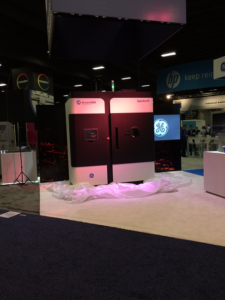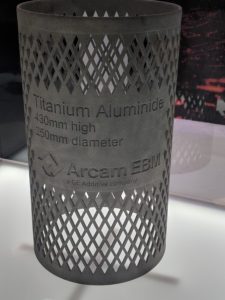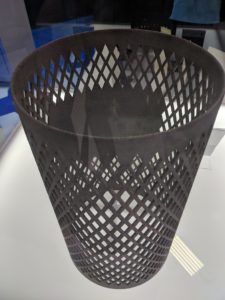One of the biggest announcements to emerge from this year’s RAPID + TCT event was the newest Electron Beam Melting (EBM) metal 3D printing system from Arcam EBM. The Arcam EBM Spectra H is a new system designed to handle high heat and crack-prone materials. Our team was looking forward to the announcement, and writer Sarah Saunders was on hand as the curtain dropped at the formal unveiling.
- The unveiling
- [Photos: Sarah Saunders]
Shortly thereafter, I enjoyed the opportunity to sit down with Arcam EBM CEO Karl Lindblom and Vice President, Product Management Annika Ölme to discuss the launch and business strategies.
“With this launch, we are taking EBM to the next level,” Lindblom said emphatically as we sat down.
“Customers have been asking for larger, faster capabilities, and have been realizing that we have a unique technology, offering handling of high heat. This is why there has been a lot of attention for this launch.”
 He pointed to improvements made in engineering, and Ölme was happy to expand upon these areas. She pointed out three keys to what makes this announcement a milestone for the company:
He pointed to improvements made in engineering, and Ölme was happy to expand upon these areas. She pointed out three keys to what makes this announcement a milestone for the company:
- Materials: We can build what no one else can, with a vacuum chamber, electron beam, and heat model impossible with other technologies to manufacture additively. (This, Lindblom added, delivers more power.)
- Productivity: We see cost efficiency and reductions, as this sytem is 50% faster with a 39% larger build volume. This leads to huge reductions in time and money (where, Lindblom added, conventional manufacturing would see more incremental improvements).
- System: This is not a machine, but a system. This allows for serial production at scale. It is not just an EBM machine; there is powder handling, a build tank, you can reuse powder without contamination, and maintain powder batch integrity and traceability for the whole manufacturing process.
These benefits are laid out in this video from Arcam EBM:
“All this shows we take into account our customers’ needs,” Ölme said in summary.
As additive manufacturing matures and sees more serious use, we often hear from more companies interested in industrial capabilities; the need to listen to users is critical for those companies that would see their offerings succeed in real-world conditions. By offering an ecosystem, not just a machine, Arcam EBM is seeking to respond directly to user needs.
“We have powder, we have support for customers who want to start in additive manufacturing with AddWorks,” Lindblom said. “We bring over to our visitors that we’re not just a machine supplier; we have a complete ecosystem to supply.”
In addition to meeting the physical needs through an ecosystem, hardware and materials suppliers must understand where the industry is going, where need is arising. For Arcam EBM, that direction is clear: production.
“Additive manufacturing going forward is really about production. The future is not about prototyping; that’s why we’re launching this now,” Ölme told me.
While of course prototyping, the original application for 3D printing, will remain a need across the board and a major application, future-looking advances are often laser focused on end-use capabilities. Metal additive manufacturing in particular is well suited for the rigors of final parts production, and each advance is another step toward seeing enhanced adoption and offerings at true scale.
“The journey of GE, the journey many go through, describes this very well,” Lindblom explained. “It takes many years — and the later you start, the later you benefit.”
Founded in 1997, Arcam offers decades of experience in this young technology, and through its close relationship with GE is able to build upon more decades of use in additive manufacturing. Arcam, a GE Additive company since its acquisition in late 2016, 95% held by GE since late 2017, has been growing to appreciate this positioning in gaining access to additional industry resources alongside new sister company Concept Laser. For its part, Concept Laser has also begun to see great strength in this positioning, as that company’s CEO told me when we spoke at formnext.
“It is growing from a technological standpoint, and this is very interesting to me as an engineer,” Ölme said of the growing industry.
 This growth is a key driver to business, as Lindblom noted, and has been attracting many talented people to join the industry — and the company. This, as he and Ölme noted, is an advantage, particularly with the integration with GE and work with sister company Concept Laser. The relationship is itself still young, and was not without its growing pains.
This growth is a key driver to business, as Lindblom noted, and has been attracting many talented people to join the industry — and the company. This, as he and Ölme noted, is an advantage, particularly with the integration with GE and work with sister company Concept Laser. The relationship is itself still young, and was not without its growing pains.
“It was difficult in the first year; however, since the first of January this year, we can interact as much as we want. We are excited about the support we can get through all this,” Lindblom told me of the integration.
“All of a sudden we are part of something much larger — for us this is very exciting. The acquisition is aiming for growth. We are scaling up technology with the resources GE has.”
Ölme agreed, adding that there are now more opportunities to drive the business forward.
“The world opens up as we see so much with GE that we can use. I don’t think it could have been better, honestly,” she said.
“It shows that we, and GE Additive, are very serious about driving the additive revolution.”
With more employees, access to a bigger campus, and a broad global portfolio of resources, Arcam is positioned to continue to grow in expertise and offerings as its focus on metal additive manufacturing continues to sharpen. Speaking with Ölme and Lindblom offered a welcome look into this company that is, in so many ways, making big things happen in metal 3D printing.
Read more here about the Spectra H; full specs are available here.
Discuss RAPID + TCT and other 3D printing topics at 3DPrintBoard.com or share your thoughts below.
[All photos: Sarah Goehrke]
Subscribe to Our Email Newsletter
Stay up-to-date on all the latest news from the 3D printing industry and receive information and offers from third party vendors.
You May Also Like
Nylon 3D Printed Parts Made More Functional with Coatings & Colors
Parts 3D printed from polyamide (PA, Nylon) 12 using powder bed fusion (PBF) are a mainstay in the additive manufacturing (AM) industry. While post-finishing processes have improved the porosity of...
3DPOD Episode 193: Flow and What’s Possible in 3D Printing with Ricky Wildman, University of Nottingham
Ricky Wildman is working on 3D printing pills, but, as Professor of Multiphase Flow and Physics at Nottingham, he does a whole lot more. His research encompasses the characterization of...
3D Printing Webinar and Event Roundup: March 17, 2024
It’s another busy week of webinars and events, including SALMED 2024 and AM Forum in Berlin. Stratasys continues its in-person training and is offering two webinars, ASTM is holding a...
3D Printed Micro Antenna is 15% Smaller and 6X Lighter
Horizon Microtechnologies has achieved success in creating a high-frequency D-Band horn antenna through micro 3D printing. However, this achievement did not rely solely on 3D printing; it involved a combination...



































